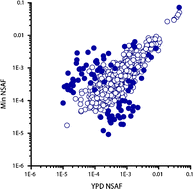Non-specific proteases are rarely used in quantitative shotgun proteomics due to potentially high false discovery rates. Yet, there are instances when application of a non-specific protease is desirable to obtain sufficient sequence coverage of otherwise poorly accessible proteins or structural domains. Using the non-specific protease, proteinase K, we analyzed Saccharomyces cerevisiae preparations grown in 14N rich media and 15N minimal media and obtained relative quantitation from the dataset using normalized spectral abundance factors (NSAFs). A critical step in using a spectral counting based approach for quantitative proteomics is ensuring the inclusion of high quality spectra in the dataset. One way to do this is to minimize the false discovery rate, which can be accomplished by applying different filters to a searched dataset. Natural log transformation of proteinase K derived NSAF values followed a normal distribution and allowed for statistical analysis by the t-test. Using this approach, we generated a dataset of 719 unique proteins found in each of the three independent biological replicates, of which 84 showed a statistically significant difference in expression levels between the two growth conditions.

You have access to this article
 Please wait while we load your content...
Something went wrong. Try again?
Please wait while we load your content...
Something went wrong. Try again?


 Please wait while we load your content...
Please wait while we load your content...